Contemporary Climate Change and Its Hydrological Consequence in the Volga Federal District, European Russia
Abstract
:1. Introduction
2. Materials and Methods
2.1. Study Area
2.2. Data and Statistical Processing
2.3. Methods
- Budyko’s Dryness Index (DI): <0.45—excessively humid climate; 0.45–1.0—humid climate; 1.0–3.0—insufficiently humid climate, and >3.0—dry climate;
- Selyaninov’s Hydrothermal Coefficient (HTC): <0.2—very severe drought; 0.2–0.4—severe drought; 0.4–0.6—moderate drought; 0.6–0.7—mild drought; 0.7–1.0—insufficient moisture; 1.0–1.4—optimal moisture; 1.4–1.6—increased moisture; and >1.6—excessive moisture;
- Sapozhnikova’s Humidity Coefficient (Sapozhnikova’s HC); it has the same gradations as the Selyaninov’s Hydrothermal Coefficient.
- Ivanov’s Humidity Coefficient (Ivanov’s HC), i.e., the ratio of annual precipitation to annual evaporation (here and below, potential evaporation): 1—optimal moisture; >1—excessive moisture; <1—insufficient moisture (<0.25–0.35—drought);
3. Results and Discussion
4. Limitations and Uncertainties
5. Conclusions
Author Contributions
Funding
Institutional Review Board Statement
Informed Consent Statement
Data Availability Statement
Conflicts of Interest
Appendix A
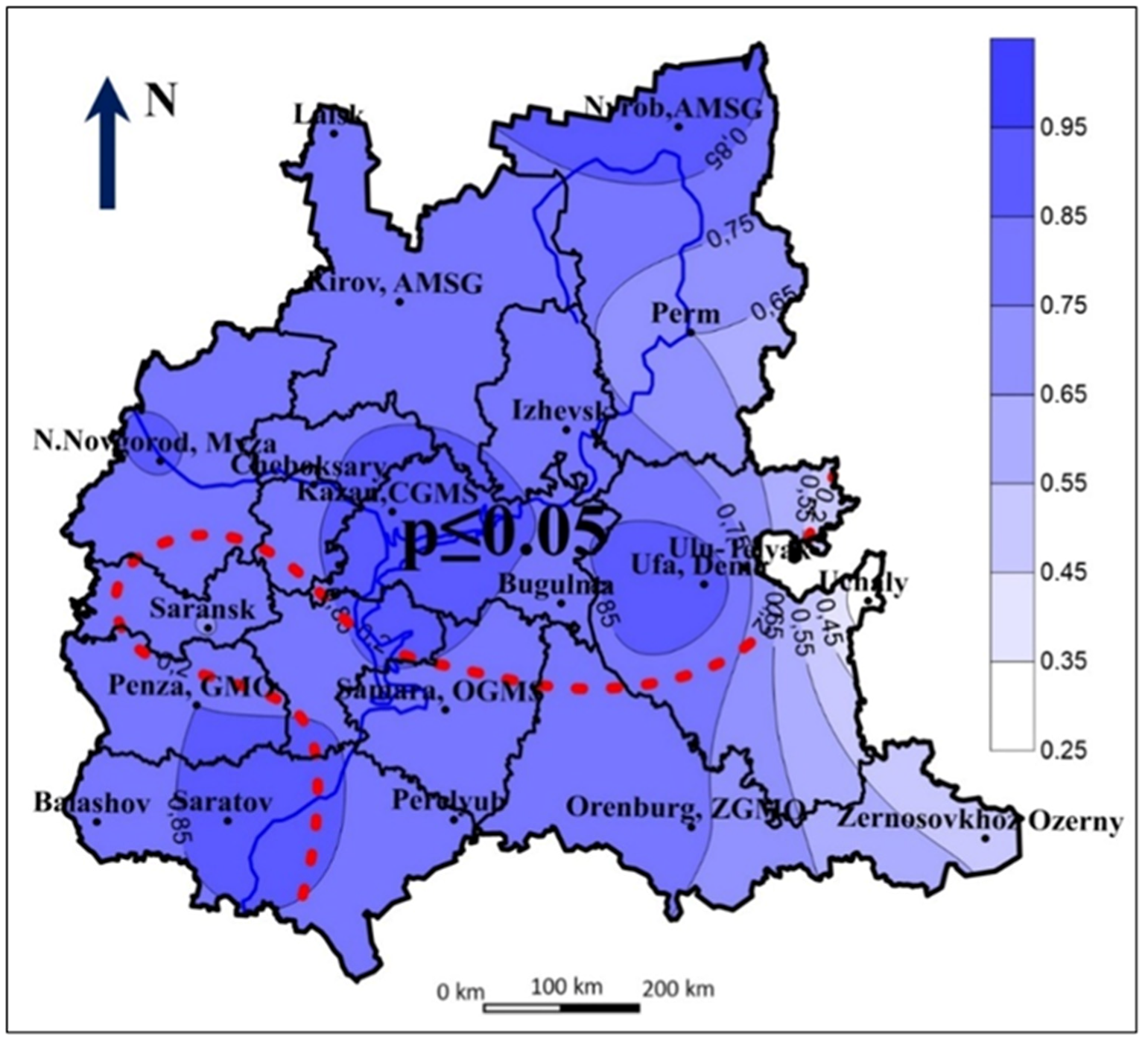
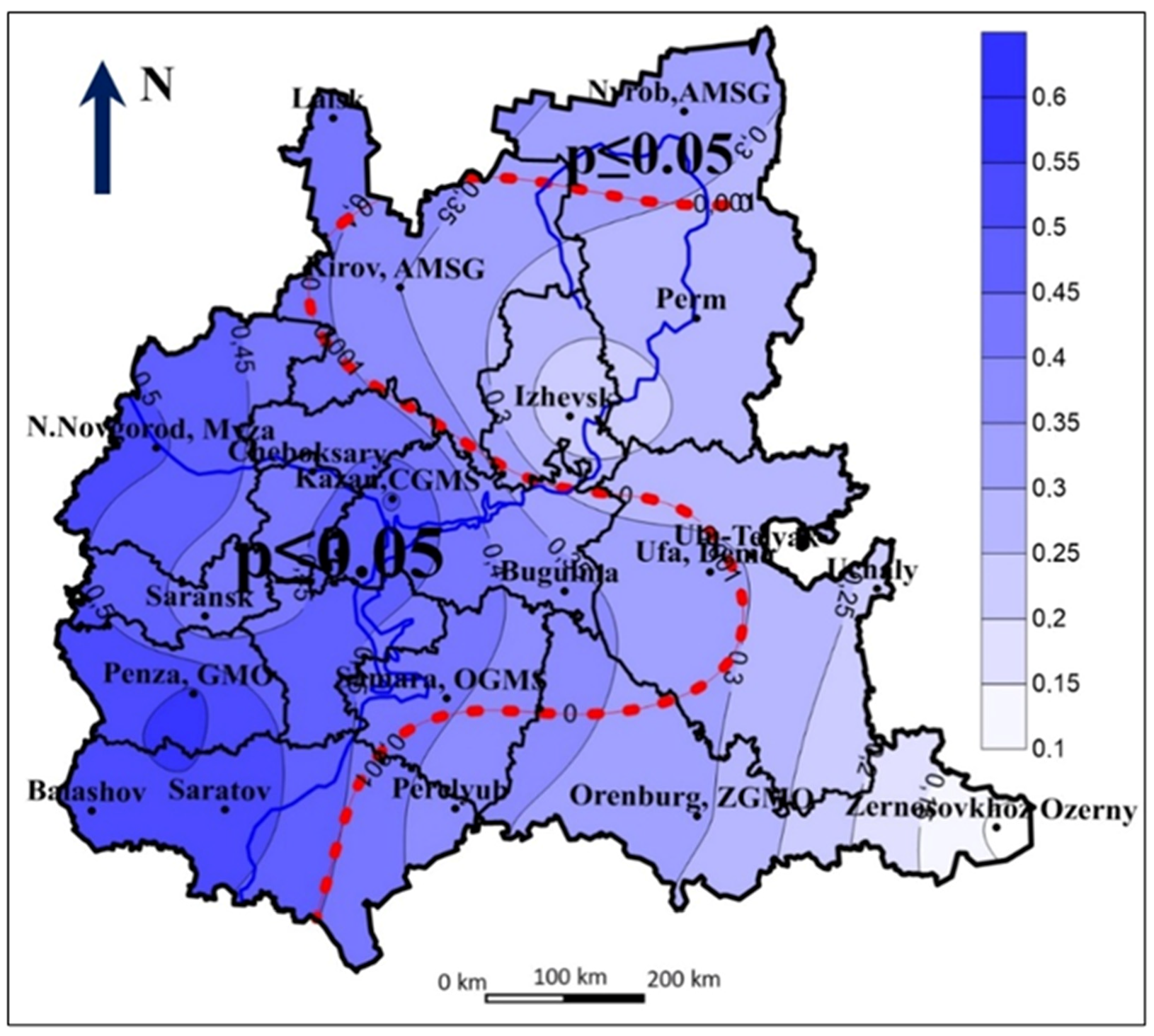
Appendix B
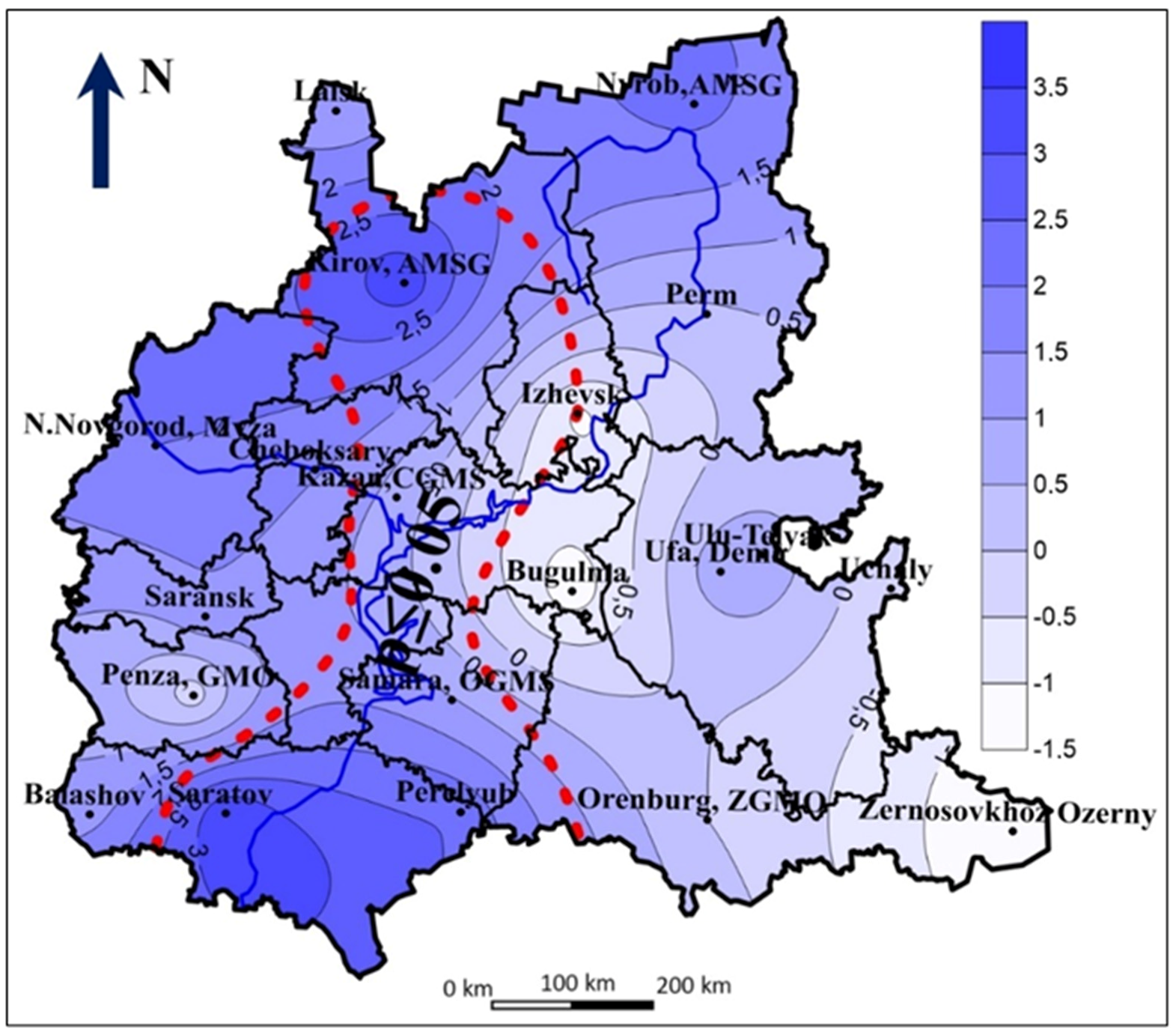
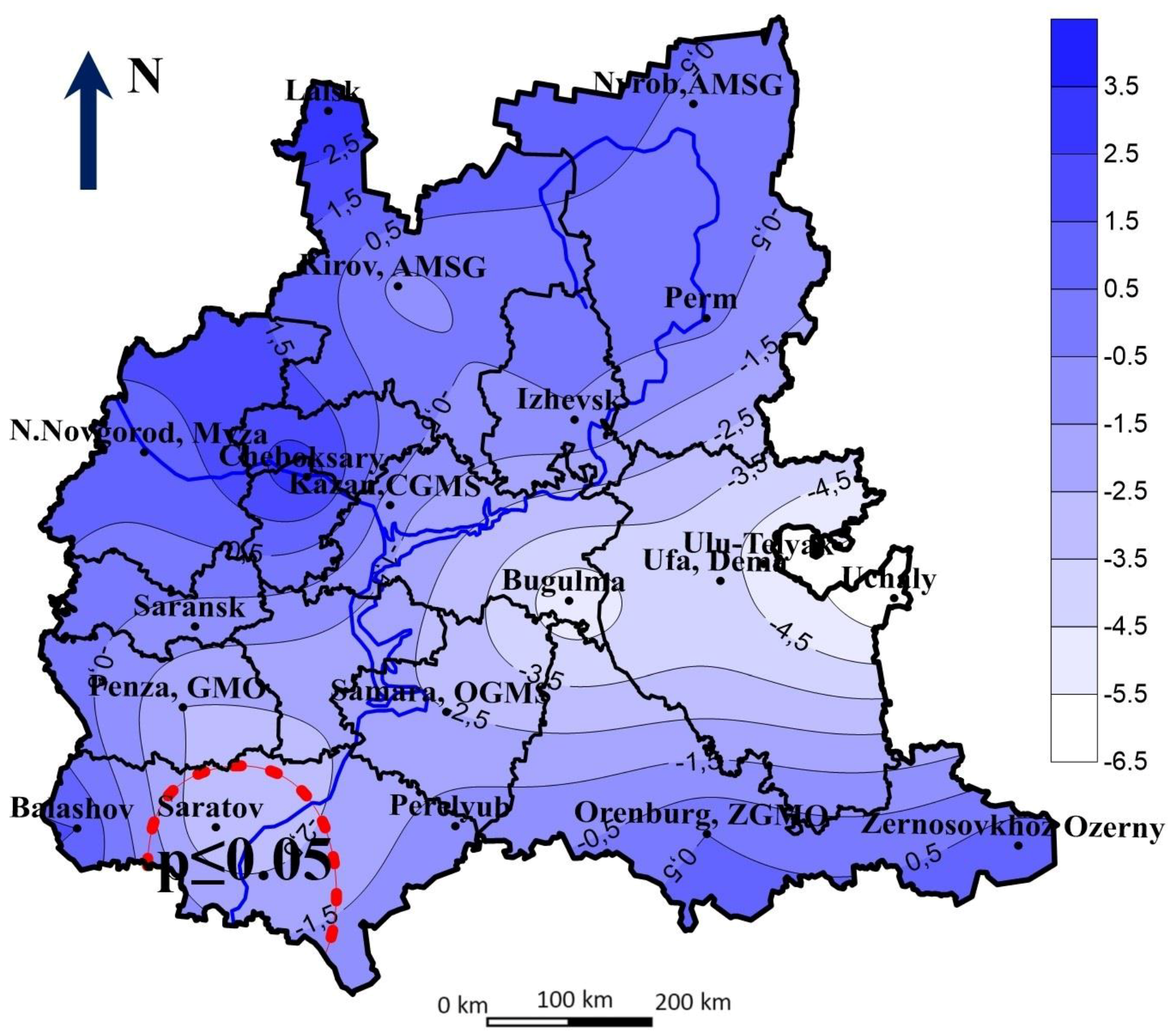
References
- IPCC. 2022: Climate Change 2022: Impacts. Adaptation and Vulnerability. Contribution of Working Group II to the Sixth Assessment Report of the Intergovernmental Panel on Climate Change; Pörtner, H.-O., Roberts, D.C., Tignor, M., Poloczanska, E.S., Mintenbeck, K., Alegría, A., Craig, M., Langsdorf, S., Löschke, S., Möller, V., et al., Eds.; Cambridge University Press: Cambridge, UK; New York, NY, USA, 2022; p. 3056. [Google Scholar]
- Gladilshchikova, A.A.; Dmitrieva, T.M.; Semenov, S.M. Special Report of the Intergovernmental Panel on Climate Change “Global Warming of 1.5 °C”. Fundam. Appl. Climatol. 2018, 4, 5–18. (In Russian) [Google Scholar] [CrossRef]
- Kolobov, N.V. The Climate of the Middle Volga Region; Publishing House of Kazan University: Kazan, Russia, 1968. (In Russian) [Google Scholar]
- Kolobov, N.V.; Murakaeva, S.A. Droughts in the Territory of the Tatar ASSR; Publishing House of Kazan University: Kazan, Russia, 1980. (In Russian) [Google Scholar]
- Perevedentsev, Y.P.; Vereshchagin, M.A.; Naumov, E.P.; Shantalinsky, K.M. Long-term variations in main characteristics of the hydrometeorological Volga basin regime. Russ. Meteorol. Hydrol. 2001, 10, 9–15. [Google Scholar]
- Perevedentsev, Y.P.; Vereshchagin, M.A.; Naumov, E.P.; Shantalinsky, K.M.; Nikolaev, A.A. Regional display of the modern climate warming in tropo- and stratospheres of the Northern Hemisphere. Izv. Akad. Nauk. Ser. Geograf. 2005, 6, 6–16. [Google Scholar]
- Perevedentsev, Y.P.; Shantalinsky, K.M.; Aukhadeev, T.R.; Ismagilov, N.V.; Zandi, R. Effect of microcirculation systems on the thermobaric conditions of the Volga Federal District. Uchenye Zapiski Kazanskogo Universiteta. Seriya Estestvennye Nauki 2014, 156, 156–169. (In Russian) [Google Scholar]
- Vereshchagin, M.A. (Ed.) Climate and Environment of the Volga Federal District; Kazan University: Kazan, Russia, 2013. (In Russian) [Google Scholar]
- Kobysheva, N.V. (Ed.) Climate of Russia; Hydrometeoizdat: St. Petersburg, Russia, 2001. (In Russian) [Google Scholar]
- Mokhov, I.I.; Semenov, V.A. Weather and climate anomalies in Russian regions related to global climate change. Russ. Meteorol. Hydrol. 2016, 41, 84–92. [Google Scholar] [CrossRef]
- Cargo, G.V.; Rankova, E.Y. Observations and Expected Climate Change in Russia: Air Temperature; IGKE: Moscow, Russia, 2012. (In Russian) [Google Scholar]
- Babina, E.D.; Semenov, V.A. Intramonth variability of daily surface air temperature in Russia in 1970–2015. Russ. Meteorol. Hydrol. 2019, 44, 513–522. [Google Scholar] [CrossRef]
- Titkova, T.B.; Cherenkova, E.A.; Semenov, V.A. Regional features of changes in winter extreme temperatures and precipitation in Russia in 1970–2015. Ice Snow 2018, 58, 486–497. (In Russian) [Google Scholar] [CrossRef]
- RosHydromet. The Second Assessment Report on Climate Change and Its Consequences in Russian Federation; RosHydromet: Moscow, Russia, 2014. (In Russian) [Google Scholar]
- Anisimov, O.A.; Lobanov, V.A.; Reneva, S.A. Analysis of changes in air temperature in Russia and empirical forecast for the first quarter of the 21st century. Russ. Meteorol. Hydrol. 2007, 32, 620–626. [Google Scholar] [CrossRef]
- Science-Intensive Technologies. Third Assessment Report on Climate Change and Its Consequences in Russian Federation. General Summary; Science-Intensive Technologies: St. Petersburg, Russia, 2022. (In Russian) [Google Scholar]
- Semenov, S.M. (Ed.) Methods for Assessing the Consequences of Climate Change for Physical and Biological Systems; RosHydromet: Moscow, Russia, 2012. (In Russian) [Google Scholar]
- Doganovsky, A.M. Land Hydrology; Russian State Hydrometeorological University: Saint Petersburg, Russia, 2012. (In Russian) [Google Scholar]
- Kotlyakov, V.M.; Koronkevich, N.I.; Barabanova, E.A. (Eds.) Questions of Geography. Sat. 145. Hydrological Changes; Publishing House “Kodeks”: Moscow, Russia, 2018. (In Russian) [Google Scholar]
- Doganovsky, A.M.; Malinin, V.N. Gidrosfera Zemli [Earth Hydrosphere]; Russian State Hydrometeorological University: Saint Petersburg, Russia, 2004. (In Russian) [Google Scholar]
- Ivanov, N.N. On the determination of evaporation values. News All-Union Geogr. Soc. 1954, 86, 189–196. (In Russian) [Google Scholar]
- Holdridge, L.R. Simple Method for determining Potential Evapotranspiration from Temperature Data. Science 1959, 130, 572. [Google Scholar] [CrossRef] [PubMed]
- Tyurk, L. Balance of Soil Moisture; Hydrometeoizdat: Leningrad, Russia, 1958. (In Russian) [Google Scholar]
- Meshcherskaya, A.V.; Golod, M.P. Catalogs of abnormal winters over the Russian territory. Proc. MGO 2015, 579, 130–162. (In Russian) [Google Scholar]
- Kryzhov, V.M.; Gorelits, O.V. The Arctic Oscillation and its impact on temperature and precipitation in Northern Eurasia in the 20th Century. Russ. Meteorol. Hydrol. 2015, 40, 711–721. [Google Scholar] [CrossRef]
- Bardin, M.Y.; Platova, T.V.; Samokhina, O.F. Variability of anti-cyclonic activity in the northern extratropics. Fundam. Appl. Climatol. 2019, 3, 32–58. (In Russian) [Google Scholar] [CrossRef]
- Popova, V.V.; Shmakin, A.B. Regional structure of surface–air temperature fluctuations in Northern Eurasia in the latter half of the 20th and early 21st centuries. Izv. Atmos. Ocean. Phys. 2010, 46, 144–158. [Google Scholar] [CrossRef]
- Popova, V.V. Present-day changes in climate in the north of Eurasia as a manifestation of variation of the large-scale atmospheric circulation. Fundam. Appl. Climatol. 2018, 1, 84–111. (In Russian) [Google Scholar] [CrossRef]
- Perevedentsev, Y.P.; Naumov, E.P. (Eds.) The Climate of Kazan and Its Change in the Modern Period; Publishing House of Kazan University: Kazan, Russia, 2006. (In Russian) [Google Scholar]
- Cherenkova, E.A.; Shumova, N.A. Potential evapotranspiration in quantity indicators of climate. Arid. Ecosyst. 2007, 13, 55–67. (In Russian) [Google Scholar]
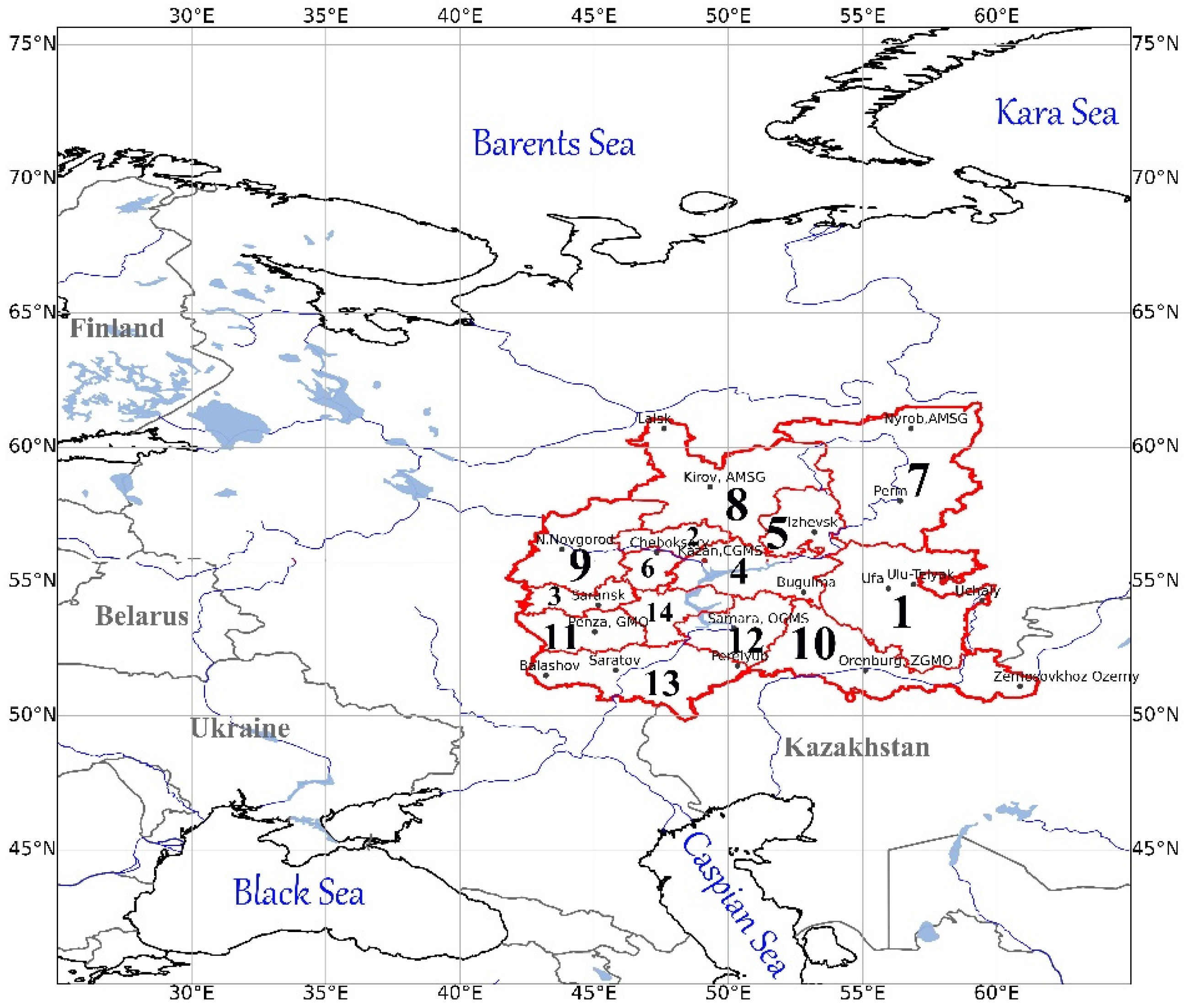
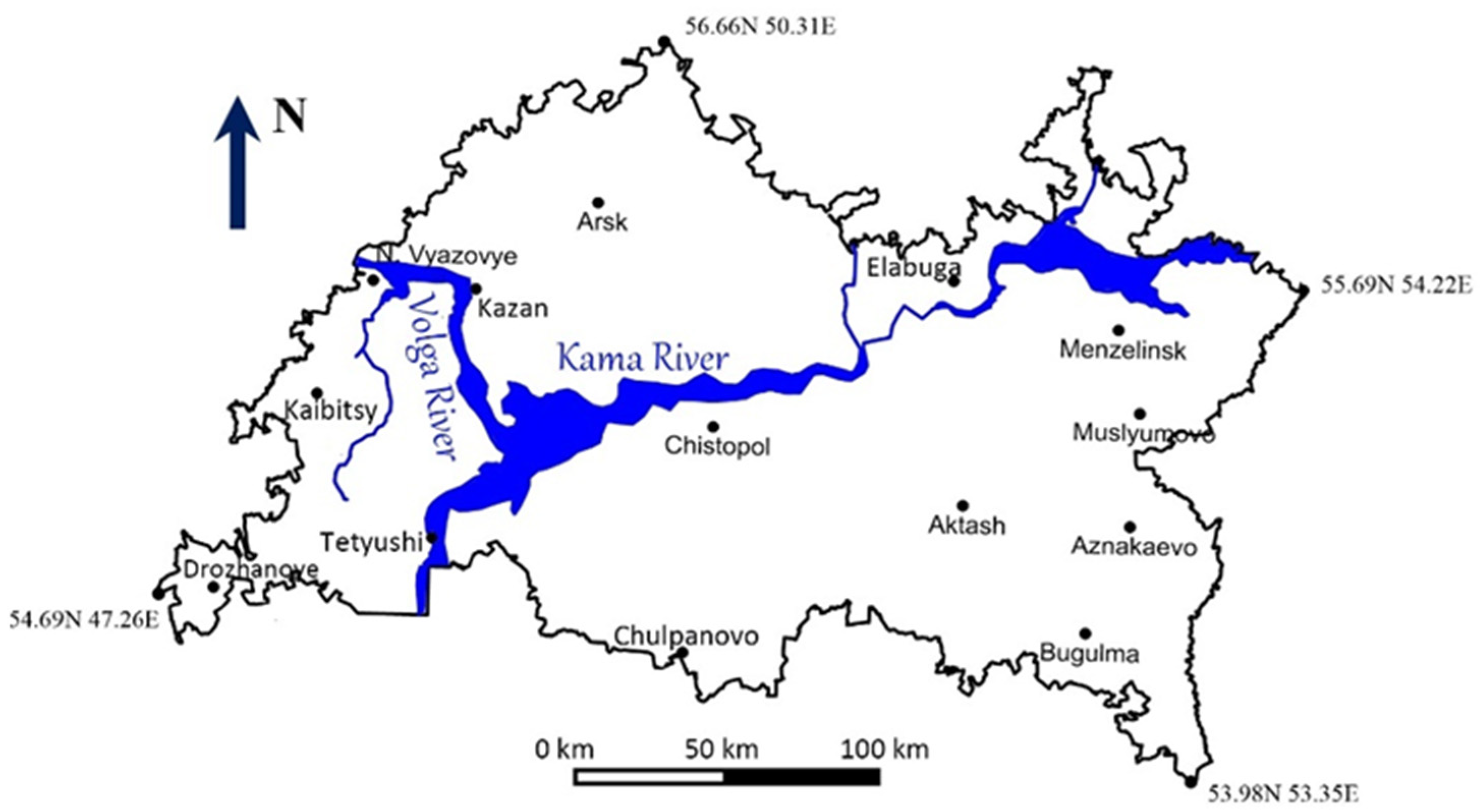

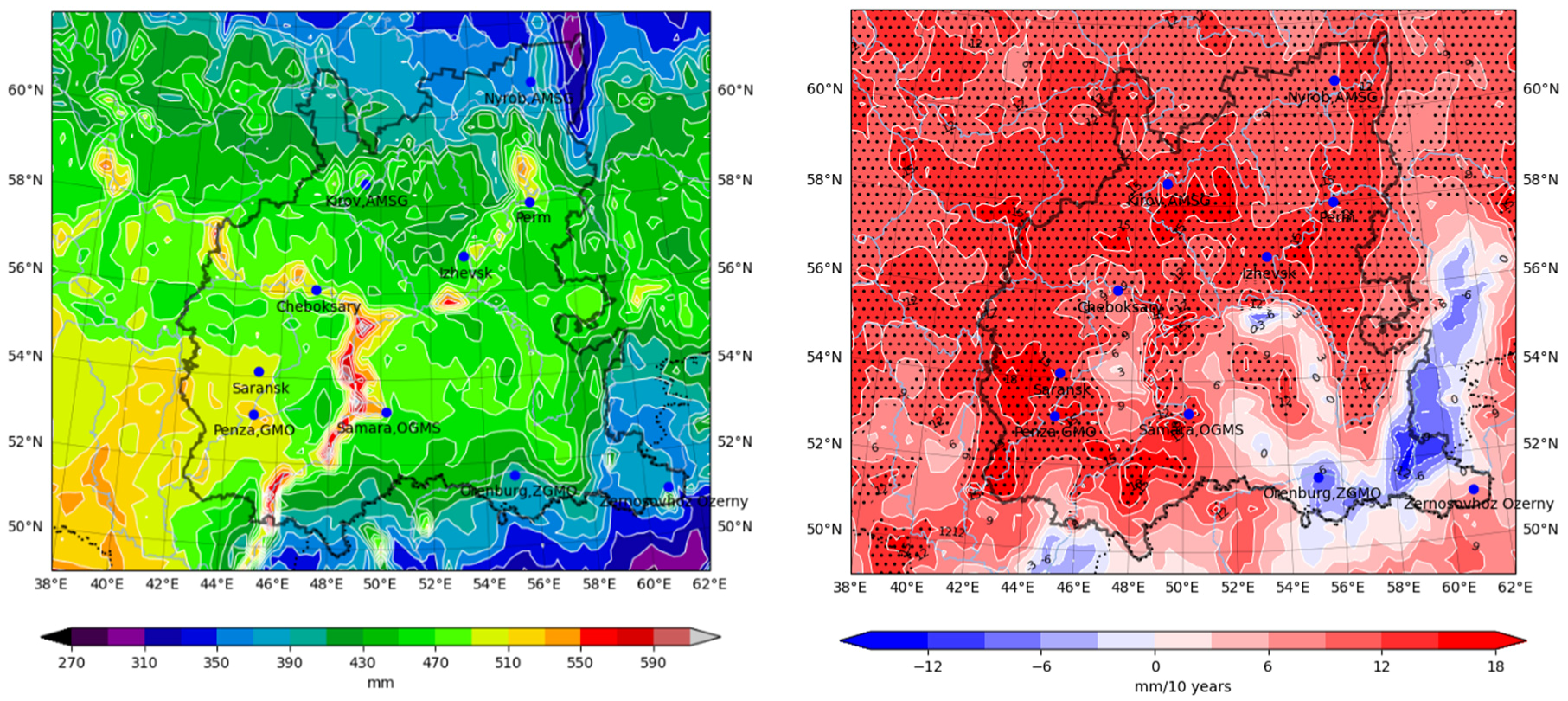

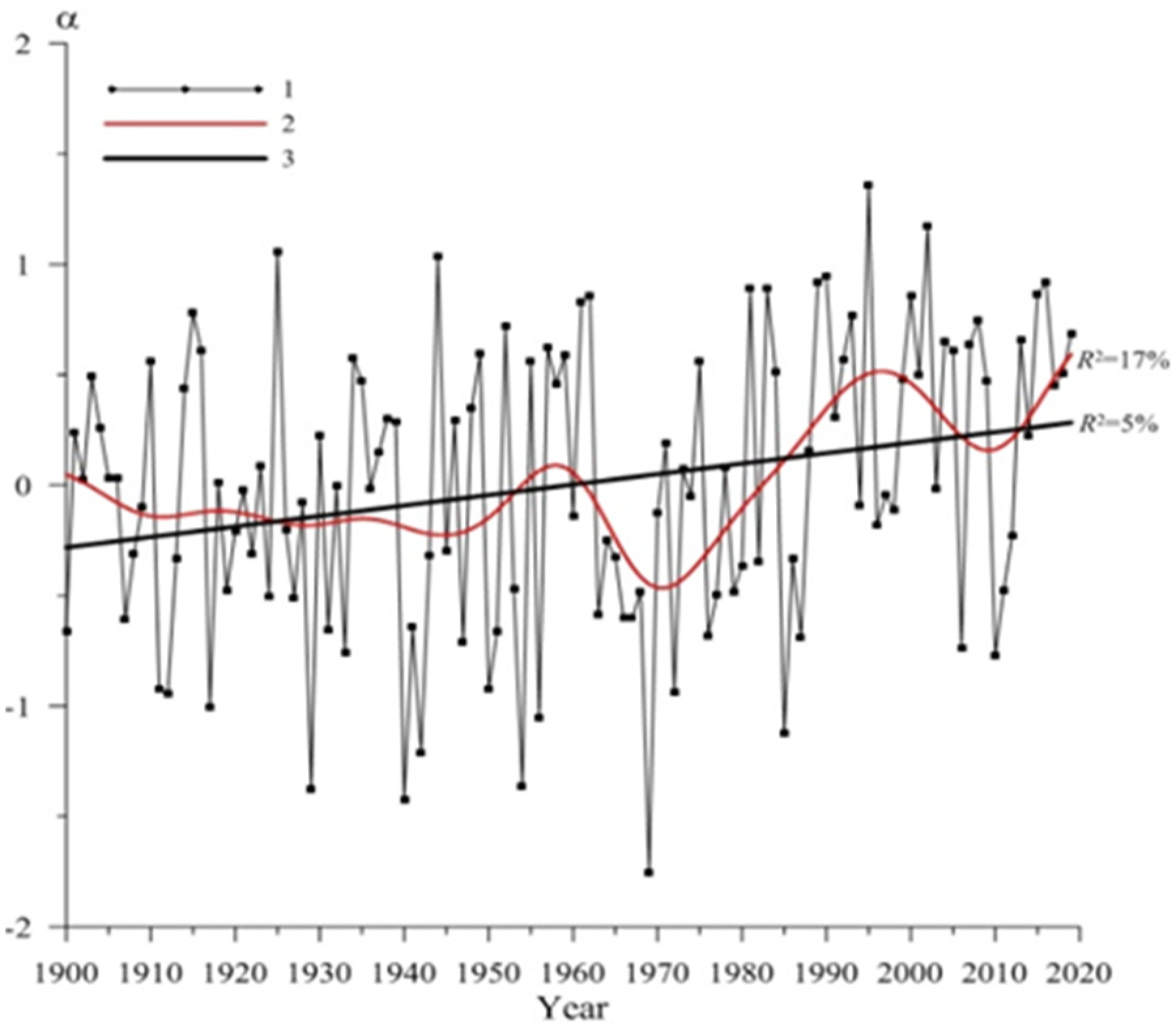
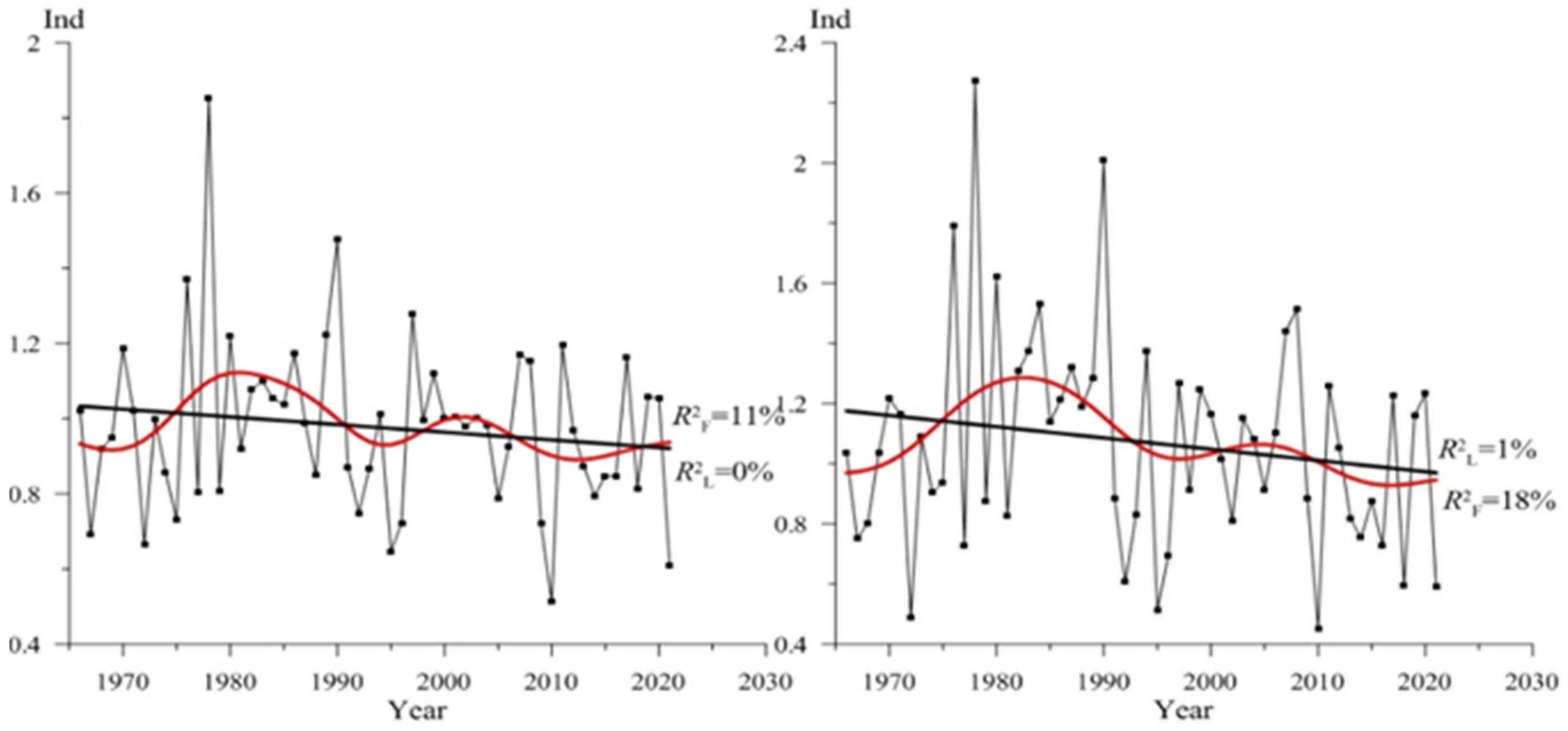

| Meteorological Station (see Figure 1) | Month | ||||||||||||
|---|---|---|---|---|---|---|---|---|---|---|---|---|---|
| I | II | III | IV | V | VI | VII | VIII | IX | X | XI | XII | Year | |
| Lalsk | −14.3 | −12.1 | −5.0 | 2.5 | 9.6 | 15.0 | 17.6 | 14.4 | 8.5 | 1.8 | −5.2 | −10.8 | 1.9 |
| Nyrob, AMSG | −16.3 | −14.0 | −6.0 | 1.2 | 8.2 | 14.5 | 17.1 | 13.5 | 7.8 | 0.5 | −7.4 | −13.5 | 0.5 |
| Kirov, AMSG | −13.0 | −11.2 | −4.2 | 4.0 | 11.5 | 16.3 | 18.7 | 15.8 | 9.7 | 2.3 | −4.6 | −10.1 | 3.0 |
| Perm | −13.7 | −11.9 | −4.4 | 3.7 | 10.9 | 16.1 | 18.3 | 15.4 | 9.6 | 2.3 | −5.4 | −11.2 | 2.5 |
| Izhevsk | −13.5 | −12.1 | −5.0 | 4.0 | 12.1 | 16.8 | 18.8 | 16.2 | 10.2 | 2.6 | −4.7 | −10.7 | 2.9 |
| N. Novgorod, Myza | −10.1 | −8.9 | −2.7 | 6.0 | 13.3 | 17.1 | 19.2 | 17.0 | 11.1 | 4.1 | −2.6 | −7.6 | 4.7 |
| Cheboksary | −11.4 | −10.4 | −4.3 | 5.0 | 13.2 | 17.2 | 19.5 | 17.2 | 11.1 | 3.8 | −3.3 | −8.8 | 4.1 |
| Kazan, CGMS | −11.6 | −10.6 | −4.0 | 5.5 | 13.7 | 17.9 | 20.1 | 17.9 | 11.7 | 4.2 | −3.0 | −8.7 | 4.5 |
| Saransk | −10.3 | −9.9 | −4.1 | 6.0 | 14.0 | 17.5 | 19.6 | 17.8 | 11.8 | 4.4 | −2.5 | −7.8 | 4.7 |
| Bugulma | −12.8 | −11.8 | −5.3 | 4.7 | 13.0 | 17.1 | 18.9 | 16.9 | 11.0 | 3.1 | −4.3 | −10.1 | 3.4 |
| Ufa, Dema | −13.6 | −12.5 | −5.1 | 5.5 | 13.5 | 17.9 | 19.6 | 17.3 | 11.3 | 3.9 | −4.0 | −10.8 | 3.6 |
| Ulu-Telyak | −13.5 | −11.9 | −4.5 | 5.4 | 12.8 | 17.2 | 19.0 | 16.5 | 10.8 | 3.7 | −4.2 | −11.1 | 3.3 |
| Uchaly | −14.6 | −13.3 | −6.6 | 3.5 | 11.0 | 15.7 | 17.2 | 15.1 | 9.3 | 1.9 | −6.1 | −12.2 | 1.7 |
| Penza, GMO | −10.0 | −9.6 | −3.5 | 7.0 | 14.7 | 18.3 | 20.2 | 18.5 | 12.4 | 5.1 | −1.9 | −7.3 | 5.4 |
| Samara, OGMS | −11.1 | −10.3 | −3.6 | 7.3 | 15.4 | 19.4 | 21.4 | 19.5 | 13.3 | 5.3 | −2.2 | −8.3 | 5.5 |
| Balashov | −8.9 | −8.5 | −2.7 | 8.0 | 15.5 | 19.1 | 21.0 | 19.7 | 13.4 | 5.9 | −1.0 | −6.3 | 6.3 |
| Saratov | −8.8 | −8.6 | −2.4 | 8.6 | 16.1 | 20.4 | 22.5 | 20.7 | 14.3 | 6.6 | −0.6 | −6.4 | 6.9 |
| Perelyub | −11.6 | −11.4 | −4.6 | 7.6 | 15.8 | 20.1 | 22.2 | 20.4 | 13.7 | 5.3 | −2.1 | −8.6 | 5.6 |
| Orenburg, ZGMO | −13.0 | −12.4 | −5.2 | 7.5 | 15.9 | 20.5 | 22.5 | 20.6 | 14.0 | 5.3 | −2.9 | −9.7 | 5.3 |
| Zernosovkhoz Ozerny | −16.2 | −15.4 | −8.3 | 5.2 | 14.2 | 19.7 | 21.3 | 19.2 | 12.5 | 3.6 | −5.3 | −12.8 | 3.1 |
| VFD average | −12.4 | −11.3 | −4.6 | 5.4 | 13.2 | 17.7 | 19.7 | 17.5 | 11.4 | 3.8 | −3.7 | −9.6 | 3.9 |
| Meteorological Station (see Figure 1) | Month | ||||||||||||
|---|---|---|---|---|---|---|---|---|---|---|---|---|---|
| I | II | III | IV | V | VI | VII | VIII | IX | X | XI | XII | Year | |
| Lalsk | 0.82 | 0.61 | 0.08 | 0.30 | 0.61 | 0.27 | 0.44 | 0.38 | 0.47 | 0.55 | 0.49 | 0.53 | 0.45 |
| Nyrob, AMSG | 0.93 | 0.51 | 0.18 | 0.38 | 0.57 | 0.33 | 0.32 | 0.35 | 0.31 | 0.66 | 0.44 | 0.31 | 0.44 |
| Kirov, AMSG | 0.76 | 0.44 | 0.16 | 0.21 | 0.51 | 0.25 | 0.35 | 0.40 | 0.41 | 0.53 | 0.34 | 0.43 | 0.40 |
| Perm | 0.65 | 0.48 | 0.29 | 0.22 | 0.44 | 0.28 | 0.28 | 0.42 | 0.36 | 0.57 | 0.34 | 0.35 | 0.39 |
| Izhevsk | 0.80 | 0.48 | 0.29 | 0.09 | 0.32 | 0.18 | 0.20 | 0.34 | 0.53 | 0.54 | 0.34 | 0.34 | 0.35 |
| N. Novgorod, Myza | 0.86 | 0.53 | 0.38 | 0.23 | 0.50 | 0.20 | 0.51 | 0.53 | 0.44 | 0.51 | 0.34 | 0.64 | 0.47 |
| Cheboksary | 0.82 | 0.29 | 0.35 | 0.21 | 0.44 | 0.25 | 0.42 | 0.53 | 0.41 | 0.55 | 0.35 | 0.53 | 0.43 |
| Kazan, CGMS | 0.95 | 0.66 | 0.53 | 0.30 | 0.46 | 0.39 | 0.51 | 0.64 | 0.43 | 0.60 | 0.42 | 0.51 | 0.53 |
| Saransk | 0.74 | 0.54 | 0.37 | 0.13 | 0.32 | 0.15 | 0.41 | 0.44 | 0.31 | 0.47 | 0.24 | 0.45 | 0.38 |
| Bugulma | 0.81 | 0.41 | 0.27 | 0.12 | 0.29 | 0.32 | 0.37 | 0.58 | 0.35 | 0.61 | 0.37 | 0.25 | 0.39 |
| Ufa, Dema | 0.95 | 0.65 | 0.50 | 0.20 | 0.25 | 0.29 | 0.32 | 0.59 | 0.29 | 0.59 | 0.37 | 0.42 | 0.45 |
| Ulu-Telyak | 1.25 | 0.96 | 0.59 | 0.12 | 0.26 | 0.25 | 0.29 | 0.65 | 0.35 | 0.51 | 0.33 | 0.53 | 0.51 |
| Uchaly | 0.26 | 0.25 | 0.17 | 0.00 | 0.19 | 0.30 | 0.24 | 0.52 | 0.21 | 0.54 | 0.28 | 0.25 | 0.27 |
| Penza, GMO | 0.85 | 0.68 | 0.43 | 0.16 | 0.37 | 0.26 | 0.56 | 0.60 | 0.41 | 0.57 | 0.27 | 0.54 | 0.47 |
| Samara, OGMS | 0.91 | 0.62 | 0.46 | 0.18 | 0.36 | 0.43 | 0.54 | 0.65 | 0.39 | 0.66 | 0.39 | 0.50 | 0.51 |
| Balashov | 0.75 | 0.58 | 0.44 | 0.14 | 0.31 | 0.15 | 0.53 | 0.56 | 0.38 | 0.50 | 0.19 | 0.43 | 0.41 |
| Saratov | 0.67 | 0.48 | 0.45 | 0.13 | 0.26 | 0.16 | 0.34 | 0.48 | 0.25 | 0.48 | 0.14 | 0.32 | 0.35 |
| Perelyub | 0.79 | 0.60 | 0.43 | 0.07 | 0.19 | 0.29 | 0.36 | 0.54 | 0.19 | 0.52 | 0.24 | 0.37 | 0.39 |
| Orenburg, ZGMO | 0.77 | 0.78 | 0.64 | 0.22 | 0.21 | 0.34 | 0.31 | 0.62 | 0.27 | 0.57 | 0.30 | 0.28 | 0.44 |
| Zernosovhoz Ozerny | 0.53 | 0.57 | 0.61 | 0.07 | 0.18 | 0.25 | 0.09 | 0.60 | 0.23 | 0.38 | 0.31 | 0.27 | 0.32 |
| VFD average | 0.81 | 0.64 | 0.30 | 0.07 | 0.25 | 0.29 | 0.31 | 0.37 | 0.34 | 0.48 | 0.20 | 0.50 | 0.38 |
| Meteorological Station (see Figure 1) | Month | ||||||||||||
|---|---|---|---|---|---|---|---|---|---|---|---|---|---|
| I | II | III | IV | V | VI | VII | VIII | IX | X | XI | XII | Year | |
| Lalsk | 40 | 31 | 32 | 36 | 49 | 70 | 77 | 68 | 55 | 60 | 54 | 48 | 619 |
| Nyrob, AMSG | 36 | 27 | 29 | 41 | 54 | 76 | 78 | 74 | 66 | 68 | 53 | 40 | 642 |
| Kirov, AMSG | 45 | 32 | 34 | 37 | 52 | 71 | 81 | 69 | 63 | 65 | 57 | 52 | 659 |
| Perm | 41 | 29 | 29 | 36 | 53 | 79 | 76 | 75 | 67 | 61 | 53 | 43 | 643 |
| Izhevsk | 33 | 25 | 26 | 30 | 40 | 62 | 66 | 61 | 53 | 53 | 43 | 34 | 526 |
| N. Novgorod, Myza | 46 | 37 | 34 | 39 | 45 | 71 | 75 | 66 | 62 | 65 | 56 | 55 | 651 |
| Cheboksary | 31 | 24 | 25 | 33 | 40 | 65 | 71 | 58 | 56 | 56 | 43 | 36 | 539 |
| Kazan, CGMS | 40 | 32 | 31 | 33 | 37 | 65 | 67 | 55 | 52 | 53 | 45 | 45 | 555 |
| Saransk | 34 | 25 | 25 | 30 | 36 | 54 | 65 | 52 | 48 | 46 | 40 | 37 | 492 |
| Bugulma | 29 | 22 | 22 | 30 | 43 | 72 | 65 | 55 | 56 | 54 | 40 | 32 | 521 |
| Ufa, Dema | 43 | 37 | 32 | 35 | 44 | 62 | 54 | 53 | 50 | 60 | 52 | 49 | 569 |
| Uchaly | 18 | 15 | 21 | 30 | 42 | 63 | 85 | 57 | 32 | 31 | 21 | 20 | 433 |
| Penza, GMO | 40 | 31 | 33 | 35 | 40 | 63 | 63 | 52 | 52 | 49 | 46 | 43 | 548 |
| Samara, OGMS | 49 | 39 | 35 | 40 | 34 | 54 | 54 | 46 | 47 | 52 | 52 | 51 | 553 |
| Balashov | 44 | 32 | 32 | 32 | 38 | 63 | 59 | 40 | 47 | 43 | 47 | 48 | 527 |
| Saratov | 42 | 32 | 32 | 32 | 37 | 50 | 48 | 36 | 46 | 36 | 45 | 42 | 480 |
| Perelyub | 39 | 30 | 29 | 26 | 28 | 49 | 40 | 33 | 40 | 40 | 39 | 41 | 434 |
| Orenburg, ZGMO | 28 | 22 | 24 | 26 | 29 | 37 | 39 | 27 | 31 | 36 | 32 | 31 | 361 |
| Zernosovhoz Ozerny | 16 | 13 | 17 | 22 | 32 | 30 | 39 | 24 | 18 | 25 | 20 | 18 | 274 |
| VFD average | 36 | 28 | 29 | 33 | 41 | 61 | 63 | 53 | 50 | 50 | 44 | 40 | 528 |
| Meteorological Station (see Figure 1) | Month | ||||||||||||
|---|---|---|---|---|---|---|---|---|---|---|---|---|---|
| I | II | III | IV | V | VI | VII | VIII | IX | X | XI | XII | Year | |
| Lalsk | 1.0 | 2.1 | 1.6 | −3.6 | −0.4 | 9.5 | 3.4 | 5.3 | 1.1 | −1.0 | −1.6 | 1.2 | 18.7 |
| Nyrob, AMSG | 2.2 | 2.0 | 2.9 | 1.9 | 1.0 | 7.9 | 0.3 | −0.1 | 0.9 | 5.3 | 2.2 | 4.4 | 30.6 |
| Kirov, AMSG | 3.4 | 1.3 | 3.5 | 0.4 | −1.9 | 5.8 | −0.8 | 1.5 | −2.2 | 1.5 | −0.7 | 4.5 | 16.3 |
| Perm | 0.4 | 0.1 | 2.8 | 2.1 | 0.2 | 6.7 | −0.2 | 3.6 | 0.1 | 1.3 | 1.8 | 3.6 | 22.4 |
| Izhevsk | −1.1 | −1.3 | 1.2 | 0.2 | 2.6 | 3.2 | −0.6 | 0.6 | 0.5 | −0.6 | −1.9 | 1.4 | 3.9 |
| N. Novgorod, Myza | 2.0 | 1.5 | 4.0 | 1.5 | −3.2 | 3.7 | 0.8 | 1.0 | 2.3 | −0.5 | −1.7 | 5.5 | 16.8 |
| Cheboksary | 1.0 | −0.5 | 2.2 | −1.5 | 0.1 | 2.4 | 3.2 | 0.7 | 1.9 | −1.1 | −0.2 | 1.9 | 10.0 |
| Kazan, CGMS | 5.1 | 1.8 | 4.4 | 0.0 | −0.1 | −3.9 | −1.0 | −1.2 | 0.9 | 0.4 | 0.7 | 6.6 | 13.8 |
| Saransk | 1.4 | 0.6 | 0.8 | −0.9 | −1.2 | −2.6 | −6.0 | −0.5 | −0.8 | −2.3 | −2.5 | 1.4 | −12.7 |
| Bugulma | −1.3 | 0.5 | 2.2 | 2.9 | 3.2 | 0.9 | −5.3 | 0.8 | −1.9 | −1.4 | 0.5 | −0.4 | −0.8 |
| Ufa, Dema | 0.9 | 0.3 | 2.9 | 0.3 | 3.8 | 2.0 | −3.9 | −0.1 | 1.1 | −1.0 | −0.2 | 2.0 | 8.1 |
| Ulu-Telyak | 0.8 | 0.3 | 3.0 | 0.7 | 1.8 | 3.8 | −5.1 | 1.2 | 0.9 | 0.1 | −0.7 | 1.9 | 8.7 |
| Uchaly | −0.4 | 0.1 | 2.6 | 2.8 | −0.1 | −3.3 | −6.4 | 4.4 | 0.9 | 2.1 | −0.2 | −0.4 | 5.8 |
| Penza, GMO | −0.3 | 1.1 | 1.7 | 2.2 | 1.8 | −1.6 | −2.5 | −1.6 | 1.0 | −1.8 | −0.2 | 0.2 | 2.2 |
| Samara, OGMS | 3.5 | 2.0 | 3.3 | 2.0 | 1.1 | −2.4 | −3.5 | −2.3 | 3.1 | 0.3 | −0.8 | 2.5 | 8.9 |
| Balashov | 1.3 | 2.7 | 2.8 | −0.7 | 4.6 | −0.8 | 1.5 | −5.2 | 2.0 | 0.4 | −1.5 | −0.1 | 7.0 |
| Saratov | 0.6 | 2.3 | 2.5 | 3.5 | 1.1 | 2.9 | −0.6 | −5.4 | 4.4 | 1.5 | −1.7 | 0.3 | 12.2 |
| Perelyub | 2.4 | 3.2 | 4.3 | 4.0 | 3.3 | 0.3 | −0.9 | 0.3 | 0.2 | 1.4 | −1.1 | 1.5 | 18.7 |
| Orenburg, ZGMO | 0.0 | 0.3 | 2.2 | 1.5 | 1.3 | −3.1 | 0.5 | −1.3 | −2.1 | −1.3 | −0.1 | −0.6 | −2.9 |
| Zernosovhoz Ozerny | −1.5 | −0.1 | 2.3 | 1.3 | 1.4 | −2.3 | 1.2 | 1.0 | −1.0 | −0.3 | 0.5 | 2.1 | 3.8 |
| VFD average | 1.1 | 1.0 | 2.7 | 1.0 | 1.0 | 1.5 | −1.3 | 0.1 | 0.7 | 0.2 | −0.5 | 2.0 | 9.6 |
| Index | Month | |||||||||||
|---|---|---|---|---|---|---|---|---|---|---|---|---|
| I | II | III | IV | V | VI | VII | VIII | IX | X | XI | XII | |
| NAO | 0.34 | 0.38 | 0.44 | −0.10 | −0.29 | −0.32 | −0.08 | −0.15 | 0.11 | −0.07 | −0.12 | 0.47 |
| AO | 0.43 | 0.33 | 0.39 | 0.06 | −0.06 | −0.13 | 0.25 | 0.01 | 0.15 | 0.11 | 0.28 | 0.41 |
| SCAND | −0.62 | −0.63 | −0.35 | −0.31 | −0.28 | −0.03 | 0.09 | −0.14 | −0.17 | −0.48 | −0.22 | −0.29 |
| Meteorological Station (see Figure 2) | Precipitation | Vaporization | Runoff | ||||||
|---|---|---|---|---|---|---|---|---|---|
| Av | SD | LTSC | Av | SD | LTSC | Av (μ) | SD | LTSC | |
| Arsk | 523 | 93 | 7.8 | 347 | 38 | 13.4 | 176 (0.34) | 88 | −5.6 |
| Elabuga | 544 | 95 | −3.0 | 369 | 35 | 8.2 | 175 (0.32) | 82 | −11.2 |
| N. Vyazovye | 484 | 91 | 12.0 | 347 | 34 | 12.2 | 137 (0.28) | 74 | −0.2 |
| Kazan | 557 | 93 | 11.4 | 380 | 40 | 16.3 | 177 (0.32) | 83 | −4.9 |
| Menzelinsk | 468 | 85 | −1.3 | 337 | 30 | 7.4 | 131 (0.28) | 69 | −8.7 |
| Kaibitsy | 471 | 84 | 7.3 | 334 | 38 | 8.5 | 137 (0.29) | 60 | −1.2 |
| Muslyumovo | 447 | 77 | 1.0 | 323 | 29 | 7.2 | 124 (0.28) | 60 | −1.2 |
| Aktash | 490 | 89 | 4.0 | 341 | 31 | 8.1 | 149 (0.30) | 76 | −4.1 |
| Aznakaevo | 500 | 101 | 1.8 | 349 | 32 | 4.5 | 151 (0.30) | 78 | −2.7 |
| Tetyushi | 482 | 92 | 5.6 | 341 | 39 | 6.8 | 141 (0.29) | 73 | −1.2 |
| Drozhanoye | 485 | 96 | −7.3 | 344 | 37 | 0.2 | 141 (0.29) | 78 | −7.6 |
| Bugulma | 516 | 103 | −6.8 | 354 | 29 | 2.0 | 162 (0.31) | 86 | −8.8 |
| Chulpanovo | 475 | 83 | −5.5 | 328 | 21 | 1.4 | 147 (0.31) | 74 | −6.8 |
| RT average | 494 | 91 | 2.1 | 346 | 33 | 7.4 | 148 (0.30) | 75 | −4.9 |
| Meteorological Station (see Figure 2) | January | July | ||||||||
|---|---|---|---|---|---|---|---|---|---|---|
| Av | SD | LTSC | R2L | R2F | Av | SD | LTSC | R2L | R2F | |
| Arsk | −12.27 | 4.05 | 0.10 | 12 | 28 | 19.44 | 2.01 | 0.04 | 6 | 17 |
| Elabuga | −12.16 | 4.09 | 0.10 | 11 | 26 | 19.94 | 1.95 | 0.03 | 4 | 15 |
| Vyazovye | −11.49 | 4.02 | 0.09 | 11 | 27 | 19.77 | 1.97 | 0.04 | 7 | 20 |
| Kazan | −11.41 | 4.00 | 0.10 | 14 | 29 | 20.04 | 2.01 | 0.05 | 11 | 22 |
| Menzelinsk | −12.82 | 4.15 | 0.10 | 10 | 27 | 19.53 | 1.94 | 0.04 | 6 | 15 |
| Kaibitsy | −11.48 | 4.07 | 0.09 | 10 | 28 | 19.41 | 1.89 | 0.04 | 6 | 19 |
| Muslyumovo | −12.86 | 4.48 | 0.09 | 8 | 26 | 19.74 | 1.82 | 0.03 | 3 | 14 |
| Aktash | −12.35 | 4.23 | 0.09 | 9 | 25 | 19.55 | 1.86 | 0.03 | 2 | 13 |
| Aznakaevo | −12.60 | 4.10 | 0.09 | 9 | 26 | 19.26 | 1.85 | 0.03 | 5 | 15 |
| Tetyushi | −11.69 | 3.99 | 0.09 | 9 | 26 | 19.49 | 1.89 | 0.04 | 7 | 19 |
| Drozhanoye | −11.24 | 3.85 | 0.08 | 8 | 25 | 19.24 | 1.97 | 0.03 | 4 | 18 |
| Bugulma | −12.59 | 3.78 | 0.08 | 10 | 26 | 18.88 | 1.97 | 0.03 | 3 | 13 |
| Chulpanovo | −12.39 | 4.24 | 0.09 | 8 | 24 | 19.65 | 1.78 | 0.03 | 2 | 14 |
| RT average | −12.10 | 4.08 | 0.09 | 10 | 26 | 19.53 | 1.92 | 0.035 | 5 | 16 |
| Meteorological Station (see Figure 2) | Budyko’s Dryness Index (Summer) | HTC | Sapozhnikova’s HC | |||
|---|---|---|---|---|---|---|
| Average Value | LTSC, un. /10 Years | Average Value | LTSC, un. /10 Years | Average Value | LTSC, un. /10 Years | |
| Arsk | 2.72 | 0.10 | 1.05 | −0.02 | 0.91 | −0.02 |
| Elabuga | 2.94 | 0.23 | 1.09 | −0.02 | 0.92 | −0.03 |
| N. Vyazovye | 3.00 | 0.04 | 1.01 | 0 | 0.83 | 0 |
| Kazan | 2.70 | 0.16 | 1.07 | −0.04 | 0.92 | −0.02 |
| Menzelinsk | 2.86 | 0.15 | 1.00 | −0.03 | 0.83 | −0.03 |
| Kaibitsy | 3.16 | 0.15 | 0.96 | −0.04 | 0.81 | −0.02 |
| Muslyumovo | 3.13 | 0.21 | 0.98 | −0.03 | 0.77 | −0.02 |
| Aktash | 3.26 | 0.17 | 0.98 | −0.02 | 0.83 | −0.01 |
| Aznakaevo | 3.05 | 0.37 | 1.06 | −0.03 | 0.88 | −0.02 |
| Tetyushi | 2.93 | 0.09 | 1.00 | −0.02 | 0.84 | −0.01 |
| Drozhanoye | 2.81 | 0.11 | 1.05 | −0.01 | 0.86 | −0.02 |
| Bugulma | 2.87 | 0.38 | 1.16 | −0.04 | 0.94 | −0.03 |
| Chulpanovo | 3.12 | 0.19 | 0.98 | −0.03 | 0.81 | −0.02 |
| RT average | 2.97 | 0.18 | 1.03 | −0.025 | 0.86 | −0.02 |
Publisher’s Note: MDPI stays neutral with regard to jurisdictional claims in published maps and institutional affiliations. |
© 2022 by the authors. Licensee MDPI, Basel, Switzerland. This article is an open access article distributed under the terms and conditions of the Creative Commons Attribution (CC BY) license (https://creativecommons.org/licenses/by/4.0/).
Share and Cite
Perevedentsev, Y.; Gusarov, A.; Mirsaeva, N.; Sherstyukov, B.; Shantalinsky, K.; Guryanov, V.; Aukhadeev, T. Contemporary Climate Change and Its Hydrological Consequence in the Volga Federal District, European Russia. Climate 2022, 10, 198. https://doi.org/10.3390/cli10120198
Perevedentsev Y, Gusarov A, Mirsaeva N, Sherstyukov B, Shantalinsky K, Guryanov V, Aukhadeev T. Contemporary Climate Change and Its Hydrological Consequence in the Volga Federal District, European Russia. Climate. 2022; 10(12):198. https://doi.org/10.3390/cli10120198
Chicago/Turabian StylePerevedentsev, Yuri, Artyom Gusarov, Nadezhda Mirsaeva, Boris Sherstyukov, Konstantin Shantalinsky, Vladimir Guryanov, and Timur Aukhadeev. 2022. "Contemporary Climate Change and Its Hydrological Consequence in the Volga Federal District, European Russia" Climate 10, no. 12: 198. https://doi.org/10.3390/cli10120198
APA StylePerevedentsev, Y., Gusarov, A., Mirsaeva, N., Sherstyukov, B., Shantalinsky, K., Guryanov, V., & Aukhadeev, T. (2022). Contemporary Climate Change and Its Hydrological Consequence in the Volga Federal District, European Russia. Climate, 10(12), 198. https://doi.org/10.3390/cli10120198







